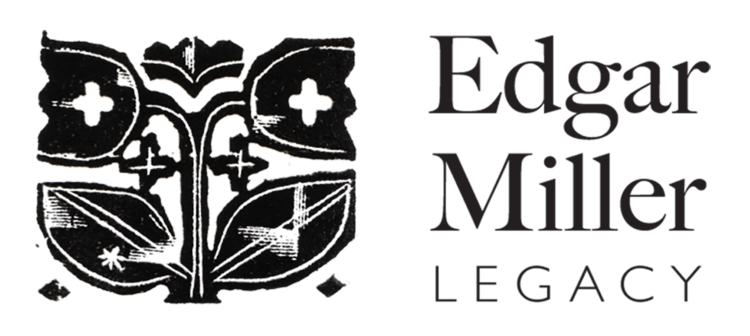Oakridge Abbey Mausoleum
Hillside, Illinois
c. 1928-1932
Stained glass windows with Hester Miller Murray
While Edgar Miller’s most recognizable work may be the “handmade home” artist studio buildings in Chicago, other impressive accomplishments are scattered around the Chicagoland area. They sit in plain sight in the form of monumental church windows, mausoleum designs, and altar displays for chapels and synagogues. Miller’s art and design turned ordinary spaces sublime, so it is no wonder that he was sought out to apply his master craftsmanship to sacred grounds. Religious art projects were some of Miller’s first professional commissions and continued to be a mainstay of his practice up until the very last few years of his career.
In the 1980s, at the behest of his colleagues and protégés, Edgar wrote out a list of all the jobs he could remember, among which are many existing churches, synagogues and cemeteries across Chicago and various suburbs. One of these sites is Oakridge Abbey Mausoleum, where Miller worked on the largest stained glass project of his career.
Sometime in the late 1920s, Edgar Miller was hired to create a large assortment of stained glass windows for the monumental crypt, which was touted as one of the most elegant and beautifully designed mausoleums in the area. Indeed, it is quite a magnificent structure.
Responsible for its construction was Anders E. Anderson. Already a real estate developer, he decided to develop cemeteries believing that a mausoleum would prove to be a lucrative venture, all while providing a serene resting place for people’s loved ones. He became president of the Oak Ridge Cemetery and then, in 1917— the year Edgar arrived in Chicago— Anderson proceeded to take out a loan for the mausoleum project from Chicago Title and Trust for $300,000 (the equivalent of over $7,000,000 today).
Detail view of the stained-glass ceiling of the chapel. Miller’s hand-painted geometric work adorns colored glass panes.
Wanting to build the project on a grand scale, Anderson traveled to Europe in 1924 during the construction of the mausoleum to find artistic and architectural inspiration. It is not entirely clear when Miller was brought onto the project, but most likely his work there began in the mid-to-late 1920s and continued past the opening of the mausoleum in 1928. Many of the later windows by Miller were commissioned by individual families who had seen the spectacular work Edgar had already installed. Any records Miller kept for the project have been lost or destroyed, so it remains unclear who even hired him, though one could assume it was Anderson himself.
Learn more about the history of the mausoleum and Anderson here, thanks to the research of Jim Craig.
An intricate bird-themed stained glass window design for the Anderson family crypt.
Walking through the building is akin to visiting a stained glass museum. The structure consists of two expansive levels and numerous hallways lined with markers and crypts of patron families, many displaying windows by Miller, Tiffany, Connick, and other well-recognized designers of the late 19th and early 20th centuries. One of the most incredible windows is a winged Madonna-like angel by Edgar Miller in the Abbey’s main chapel.
Angel window above the main chapel altar (without backlighting).
Ornate door windows, with each dove, flower, or other ornament painted in a totally variated design.
The abundance of Miller’s stained glass work at Oakridge Abbey is profound. While there are many great examples of the artist’s stained glass work in other churches, public spaces, and homes, the collection of pieces at Oakridge is by far the largest and was made during the height of Miller’s prowess with the art form. Each window has its own sense of style and character, and within each set are vibrant details.
During this time, Edgar was concurrently working on the Carl Street Studios and Kogen-Miller Studios projects in Chicago, and this was on top of many other small projects and private commissions. It’s incredible that Miller was able to attend to so many jobs at once and to produce the amount of work in such a short amount of time. One reason the work all got done was due to the help of Edgar’s sister, Hester Miller Murray. After learning Edgar’s technique, she painted many of the patterns for the stained glass so that the work of individually hand-painting each pane could be cut in half.
Hester, like her brother, was also highly talented in cutting and manipulating metal and worked on several other projects with Edgar during this time, including the Trustees Systems Service Building. However, she regularly insisted that Edgar be the only signer of the work as she felt her contribution was as an assistant. Eventually she agreed to sign the windows with her brother that they made for the Medinah Athletic Club in 1929.
The Miller siblings’ incredibly detailed work for Oakridge Abbey is shown in the gallery below:
Due to the age of the site, some of the windows at the Oakridge Abbey Mausoleum are in a state of gradual disrepair. As interest in Edgar Miller’s work grows, preservation efforts to restore these windows will be possible. Researcher and conservationist Ali Wysopal produced her Masters of Science in Historic Preservation thesis on the Oakridge Abbey site and her well-documented research can be found here.












